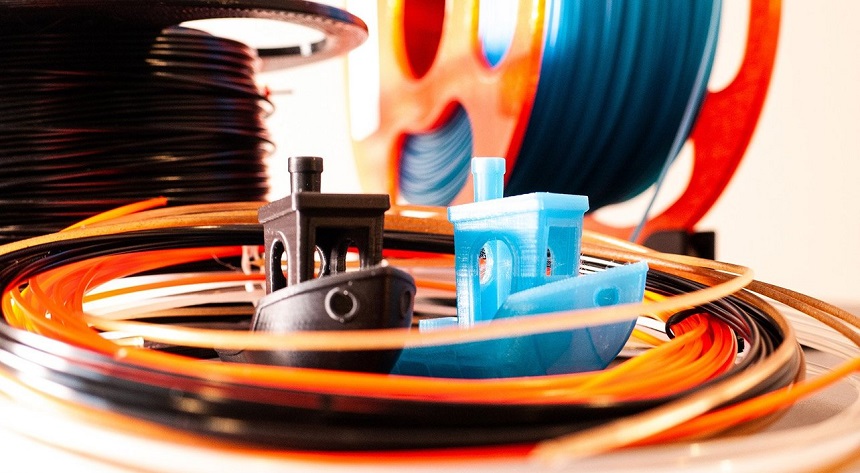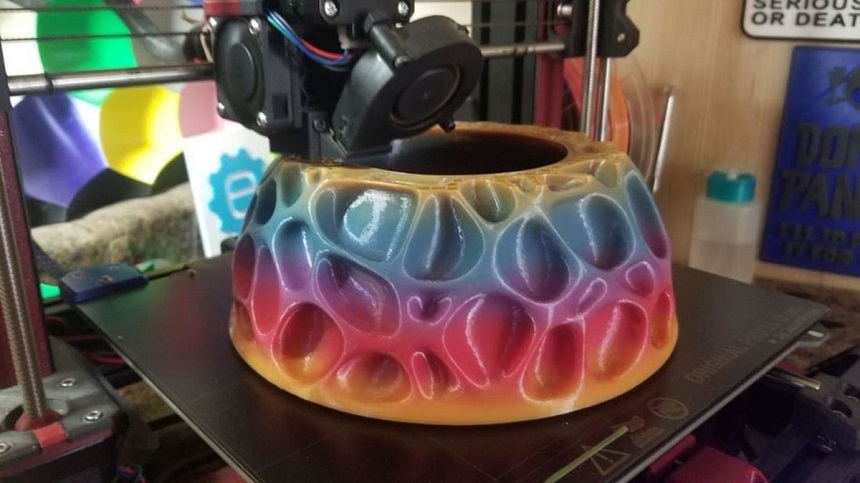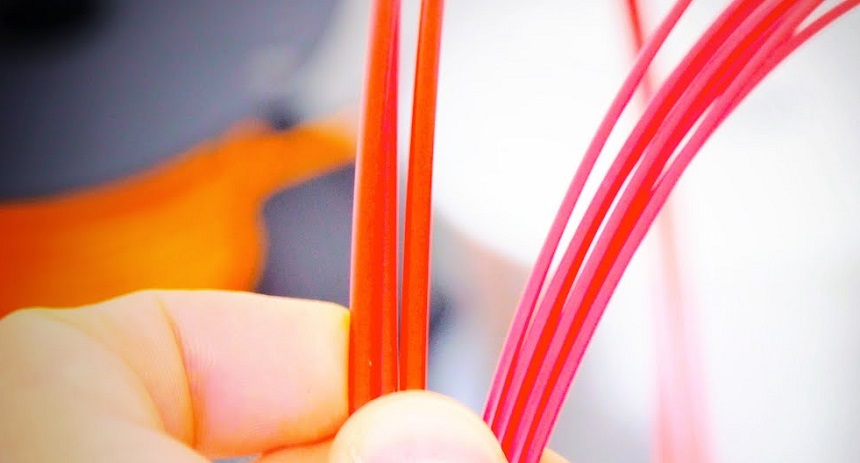

Do you want a seamless, smooth finish to your 3D prints? And why not have the x-factor with rainbow coloring? We have done all the research to help you! The filaments we have reviewed are the top of the game for high-quality printing products, often with a beautiful sheen.
We looked for the best rainbow filament, and among the features we looked at were print quality, color and sheen. If you wish for some color, a number of these filaments offer a gradual change in color. Furthermore, we wanted to see if the filaments printed well, without sticking. And how much the filaments clogged up the machine or caused bubbling. We also looked at how shiny the end-product was and if that shine was uniform. Based on all these features, we have created a handy table for you as a quick overview. There’s also a buying guide to help you make the right choice for your next 3D printing project.
More features: suitable for hanging on a lot of FDM 3D printers
The Yousu Silk Rainbow PLA Filament filament is our editor’s choice and our absolute favorite product because it provides consistent results over a wide variety of different prints. The high-quality prints that YOUSU is known for provide you with smooth printing, low shrinkage as well as no clogging or bubbling! With the strength of PLA+, this is the ideal rainbow filament for outdoor projects that require a stronger, more durable material.
Compiling a list of the top rainbow filaments wouldn’t be complete without a product from YOUSU! Well known for their quality 3D-related products, their rainbow filaments don’t disappoint. Every printing aspect – shine, smoothness, layer adhesion, stringing, and strength – is top-notch!
Unlike other filaments on the list, such as the PLA Filament by TTYT3D, the YOUSU is constructed from PLA+, which is stronger than regular PLA. If it’s the strength you’re looking for, you should consider the Yousu Silk Rainbow PLA Filament!
More features: strong compatibility, 100% tangle-free tips
This rainbow filament comes highly recommended because the filament color changes fairly rapidly (every 3 – 5 meters) compared to any other printer. It also has a silky finish and does not clog or bubble.
As a specialty filament, it is 1.5kg, not the usual 1 kg. This rainbow filament was firstly selected for the fact that it changes color fairly rapidly, meaning that you truly get multicolors in your end-product. Secondly, the product doesn’t bubble or clog.
Compared to many other products on the market, it changes color very rapidly. While it may only change every 10 meters rather than the manufacturer’s stated 3-5 meters, it is still going to give you a truly multicolored filament.
More features: easy to print
The manufacturer claims that this rainbow PLA filament changes every 3 – 5 meters. While this may not be true in practice, it certainly gives a beautiful sheen. The reviewers also found that many people were able to print well when using the correct nozzle and temperature. We chose this filament for its sheen and beautiful colors. It also prints well, for the most part.
This rainbow PLA filament gives a really good shine to the end-product. This is different from the MIKA 3D, where they shine isn’t consistent on the product. Color may not change, in practice, as rapidly as the MIKA 3D, but the colors are really stunning. However, some reviewers had issues with the filament getting stuck, despite experimenting with various settings.
More features: premium quality, vacuum package with desiccant
The PLA Silk Rainbow Filament provides one of the best satin silk luster effects of all the products we tested! Color changes every 15 – 17 meters, so you’ll only get the full effect if you print a large project. High-quality raw materials make it easy to use and avoid nozzle jamming and minimal deformation.
A smooth extrusion makes for uniform winding without any filament tangling. Additionally, this filament has a stronger layer of adhesion which always leads to a better first printed layer.
This particular rainbow filament changes color every 15 – 17 meters. Compared to the Shiny Silk Rainbow PLA Filament by MIKA3D, this is considerably longer. A longer distance between color changes makes it the ideal filament for larger projects where you can get the full effect of each color.
More features: odorless, made of natural materials
The iSANMATE 3D Printer Filament is the perfect filament if you need to print projects weighing more than 300g. With its bright rainbow colors, you can expect a project that features constantly changing colors and provides a final result of a multi-rainbow mix! Reliable, durable, and made from natural materials, this filament is compatible with all 1.75mm printers. Since this filament doesn’t require a heating bed, it’s the perfect application for 3D pens and printers such as the Ender 3, Mendel, and Monoprice.
We added this popular product to our list because it’s so easy to use and provides an amazing-looking end product! An impressive mixture of hues and glosses makes this an ideal option to consider if you’re looking for a rainbow-colored product!
When you compare this rainbow filament to a few of the others on the list, it’s crucial to note that this unit doesn’t require a heating bed. It’s ideal for use with a 3D pen and FMD printers such as the ever-popular Ender 3!
More features: tangle and clog-free, highly compatible
The AMOLEN PLA 3D Printer Filament is a popular choice among hobbyists, and it’s easy to see why. Its shiny multicolor filament changes color every 15 meters offering red, green, and yellow. With its clear texture and shiny appearance, this product is ideal for large prints where you get the full effect of all the various colors. If you intend to print lithophanes, the AMOLEN is regarded by some as the ideal filament!
AMOLEN’s shiny PLA Filament made it to our list of favorites because of its high compatibility with most FDM 3D printers. These include LulzBot, MakerBot, Mendel, MakerGear, and YOUSU. It’s always easier to get a filament that’s compatible than to struggle to find the right one for your Printer.
Unlike some of the other models on our list, such as the Aystkniet PETG Filament, this filament has an impressive end result with the promised shiny and even silky result!
More features: +/- 0.02 mm accuracy, fits most FDM printers
If you’re looking for a filament with superior precision, you’ll love the Aystkniet PETG filament as much as we do! The tolerance of 0.02mm precision – better than the 0.05mm standard – ensures you’ll have no shrinkage or warping! It melts well, doesn’t clog the nozzle, and feeds smoothly.
Aystkniet’s premium PETG filaments are made from premier materials and will easily meet any of your printing demands. Quality materials ensure you have ease of printing and higher purity with low shrinkage. The superb layer bonding makes for a great end product!
Unlike filaments such as the Shiny Silk Rainbow PLA Filament by MIKA3D, this product is more suited to bigger print types. If you’re using your 3D Printer for prototypes or work projects, this is a perfect filament to consider!
If you do a lot of 3D printing, you’ll undoubtedly know exactly what you need and what to expect from your chosen rainbow filament brand. You could even already have a favorite brand. On the other hand, if you’re a hobbyist just getting into the swing of things, you might be slightly overwhelmed by all the rainbow PLA filaments on the market.
As with 3D printers, it’s important to note that not all filaments are the same or provide similar results. Once you know what you want to print, it becomes necessary to find a filament with the features that will give you the best end result. We’ve compiled a handy buyer’s guide to help you identify the top features to consider when you’re shopping for the perfect rainbow filament. Keep reading for a closer look at these features and why they’re important!
Rainbow filaments are the ideal way to create a multicolored 3D project without having to layer one color on top of each other using different colors and a complex process. This type of filament makes printing items such as toys and ornaments a firm favorite among hobbyists. Some of the top features include material, printing temperature, and diameter. While some features can seem more important, it’s important to keep your end project in mind. Read on for a better understanding as to why these features are so important!

The material used for nearly all rainbow filaments is PLA, which is polyester made of a combination of fermented plant starches. This material is useful for any hobby or display objects such as ornaments or even toys but is not strong enough for professional use.
If you’re going to need a filament for printing prototypes or items used outdoors, you should consider PLA+.
What you may like the best about it is that it’s biodegradable once outside in the environment but very durable for those homemade objects. It’s also made from renewable resources such as corn starch, maize, or even sugar beet pulp! Filaments such as the 3D Printer by iSANMATE Store is made from natural materials, and as an added benefit, it’s also odorless! So, when purchasing your filament, determine what you’ll use it for. Then purchase filament strong enough for that application.

The idea of a rainbow filament is to provide you with a variety of colors, one after the other. This means you could start printing in green, and as the print continues, the green becomes red, and then yellow or purple, depending on the colors on offer on the filament.
The end-product color you can obtain depends on the filament that you use, how much infilling you do, and how large your object is. For MIKA3D filament, you will almost certainly see quite a remarkable color change in your finished object – truly demonstrating rainbow colors. This may happen to a slightly lesser degree with the PLA Filament by TTYT3D, but the other filaments are more likely to show a gradual color change.
Of course, any silk filament will give lovely iridescence to your creation if you like this kind of finish. It’s important to bear in mind that using a large filament on a smaller print object will only render one of two colors.

For the most part, FDM 3D printers use a filament with a diameter of 1.75 mm. Always check this before buying a new brand you haven’t used before. The Aystkniet PETG filament and the 3D Printer by iSANMATE Store are only two examples of the 1.75mm diameter found on most standard filaments.
It’s important to know the temperature parameters required for a successful print. Generally, rainbow filaments aren’t much different from the ordinary settings used for regular PLA filaments.
The recommended temperature to use varies between 185 – 230°C.
Always look for a product that falls within this category. Anything lower will give you an inferior product. It’s important to remember that if you want a glossier surface on the finished product, you’ll need to increase the extrusion temperature.
Our review features the PLA Silk Filament by Enotepad Store that yields a printing temperature of 200°C-230℃. If you require a lower printing temperature, you should consider the PLA Silk Filament by Enotepad Store, which has a color change every 15 – 17 meters. Color might not always be even or always be as shiny as advertised. Be sure to check rainbow filament reviews to determine if other users are happy with the general end result.
One of the aspects that can make or break the success of your filament is its compatibility with your printer. It’s important to check if the filament you’re considering works with your printer before buying it.
Since the average FDM 3D printer has a diameter of 1.75mm, we specifically chose filaments in this category to ensure you’d have the required fit. The Shiny Silk Rainbow PLA Filament by MIKA3D, as well as the AMOLEN PLA 3D Printer Filament, are well known for being compatible with all FDM 3D printers.
The filament is measured in weight. It’s important to remember that since PLA has a higher density, 1kg of PLA is significantly more than 1kg of a different material such as copper fill. Ensuring you have enough filament upfront will keep you from running out mid-print!
Invest in a digital scale to determine the actual weight difference between the spool when it’s full and when it’s empty. This will give you the weight difference between what’s actually filament and what’s filament plus spool.
Bear in mind that package weight could indicate filament plus spool, so you could potentially be short if you assume total package weight equals total filament. Always check if the package gives you a separate spool weight. If it does, simply subtract that from the total weight, and you’ll have an idea of how much filament you’ll actually have to work with!
3D printing enthusiasts have two basic tips that new hobbyists or casual printers might find useful.
Handy spreadsheet: Draw up a spreadsheet of different spool weights. That way, if you buy different brands, you can keep a record of the spool weights. This makes it easy to calculate the amount of filament you have to work with.
Determine various spool weights: Weigh your empty spools and record them on your spreadsheet. This is particularly important if you’re printing a bigger project.
To give you an idea of the varying weights, our review list features the Shiny Silk Rainbow PLA Filament by MIKA3D that weighs 1.5kg and the PLA Silk Filament by Enotepad Store only weighs 1kg.
We hope our informative review of our 7 best rainbow filaments will make it easier for you to choose the ideal option for your Printer and your project! Let’s revise the three options that amazed us the most. The YOUSU Rainbow Silk PLA+ filament is our editor’s choice, and we rated it at 9.8. This filament really impressed us because it consistently provides superior results over an extensive range of prints. With this filament, you can look forward to low shrinkage and no clogging. Additionally, it’s PLA+ making it stronger and more durable than some of the other options.
On the other hand, the Shiny Silk Rainbow PLA Filament by MIKA3D, rated at 9.7 and our premium pick, is worth considering because it’s a specialty filament weighing 1.5kg, making it ideal for bigger/taller projects. It also changes color sooner than other filaments giving you a more extensive color range on your project!
Last but not least, there’s our best value option, the PLA Filament by TTYT3D, which we rated at 9.6. With this filament, you can be assured of a shorter color change, ease of use, and a stunning color combination on your end result!